Data modeling 101 - Basics - Software Domain
- 1. DATA MODELING December 2023 ABDUL AHAD Data Modelling 101
- 2. WHAT IS DATA MODEL Good data allows organizations to establish baselines, benchmarks, and goals to keep moving forward. In order for data to allow this measuring, it has to be organized through data description, data semantics, and consistency constraints of data. A Data Model is this abstract model that allows the further building of conceptual models and to set relationships between data items. An organization may have a huge data repository; however, if there is no standard to ensure the basic accuracy and interpretability of that data, then it is of no use. A proper data model certifies actionable downstream results, knowledge of best practices regarding the data, and the best tools to access it.
- 3. WHAT IS DATA MODEL
- 4. WHAT IS DATA MODEL
- 5. WHAT IS DATA MODELING ? Data Modeling in software engineering is the process of simplifying the diagram or data model of a software system by applying certain formal techniques. It involves expressing data and information through text and symbols. The data model provides the blueprint for building a new database or reengineering legacy applications. In the light of the above, it is the first critical step in defining the structure of available data. Data Modeling is the process of creating data models by which data associations and constraints are described and eventually coded to reuse. It conceptually represents data with diagrams, symbols, or text to visualize the interrelation. Data Modeling thus helps to increase consistency in naming, rules, semantics, and security. This, in turn, improves data analytics. The emphasis is on the need for availability and organization of data, independent of the manner of its application.
- 6. DATA MODELING PROCESS Data modeling is a process of creating a conceptual representation of data objects and their relationships to one another. The process of data modeling typically involves several steps, including requirements gathering, conceptual design, logical design, physical design, and implementation. During each step of the process, data modelers work with stakeholders to understand the data requirements, define the entities and attributes, establish the relationships between the data objects, and create a model that accurately represents the data in a way that can be used by application developers, database administrators, and other stakeholders.
- 7. LEVELS OF DATA ABSTRACTION Data modeling typically involves several levels of abstraction, including: Conceptual level: The conceptual level involves defining the high-level entities and relationships in the data model, often using diagrams or other visual representations. Logical level: The logical level involves defining the relationships and constraints between the data objects in more detail, often using data modeling languages such as SQL or ER diagrams. Physical level: The physical level involves defining the specific details of how the data will be stored, including data types, indexes, and other technical details.
- 8. DATA MODELING EXAMPLES 1. ER (Entity-Relationship) Model This model is based on the notion of real-world entities and relationships among them. It creates an entity set, relationship set, general attributes, and constraints. Here, an entity is a real-world object; for instance, an employee is an entity in an employee database. An attribute is a property with value, and entity sets share attributes of identical value. Finally, there is the relationship between entities. 2. Hierarchical Model This data model arranges the data in the form of a tree with one root, to which other data is connected. The hierarchy begins with the root and extends like a tree. This model effectively explains several real-time relationships with a single one-to-many relationship between two different kinds of data. For example, one supermarket can have different departments and many aisles. Thus, the ŌĆśrootŌĆÖ node supermarket will have two ŌĆśchildŌĆÖ nodes of (1) Pantry, (2) Packaged Food.
- 9. DATA MODELING EXAMPLES 3. Network Model This database model enables many-to-many relationships among the connected nodes. The data is arranged in a graph-like structure, and here ŌĆśchildŌĆÖ nodes can have multiple ŌĆśparentŌĆÖ nodes. The parent nodes are known as owners, and the child nodes are called members. 4. Relational Model This popular data model example arranges the data into tables. The tables have columns and rows, each cataloging an attribute present in the entity. It makes relationships between data points easy to identify. For example, e-commerce websites can process purchases and track inventory using the relational model.
- 10. DATA MODELING EXAMPLES 5. Object-Oriented Database Model This data model defines a database as an object collection, or recyclable software components, with related methods and features. For instance, architectural and engineering real-time systems used in 3D modeling use this data modeling process. 6. Object-Relational Model This model is a combination of an object-oriented database model and a relational database model. Therefore, it blends the advanced functionalities of the object-oriented model with the ease of the relational data model. The data modeling process helps organizations to become more data-driven. This starts with cleaning and modeling data. Let us look at how data modeling occurs at different levels.
- 11. BENEFITS OF DATA MODELING 01 Improved understanding of data Data modeling helps stakeholders to better understand the structure and relationships of the data, which can help to inform decisions about how to use and store the data. 02 Improved data quality Data modeling can help to identify errors and inconsistencies in the data, which can improve the overall quality of the data and prevent problems later on. 03 Improved collaboration Data modeling helps to facilitate communication and collaboration among stakeholders, which can lead to more effective decision-making and better outcomes. 04 Increased efficiency Data modeling can help to streamline the development process by providing a clear and consistent representation of the data that can be used by developers, database administrators, and other stakeholders.
- 12. LIMITATIONS OF DATA MODELING 01 Limited flexibility Limited flexibility: Data models can be inflexible, making it difficult to adapt to changing requirements or data structures. 02 Complexity Complexity: Data models can be complex and difficult to understand, which can make it difficult for stakeholders to provide input or collaborate effectively. 03 Time-consuming Data modeling can be a time-consuming process, especially for large or complex datasets.
- 13. SIGNIFICANCE PRIMARY REASONS FOR USING A DATA MODEL Visual representation of data helps improve data analysis. It provides a holistic picture of the data which can be used by developers to create a physical database. All important data of an enterprise are accurately presented in the model. The data model reduces the chances of data omission. Data omission can lead to incorrect results and faulty reports. The data model portrays a better understanding of business requirements. It helps in the creation of a robust design that brings the entire data of an organization on the same platform. It assists in identifying the redundant, duplicate, and missing data as well. A qualified data model helps in providing better consistency across all projects of an enterprise. It improves data quality. It helps Project Managers with a better scope and quality management. It also improves performance to the core. It defines relational tables, stored procedures, and primary and foreign keys.
- 14. ADVANTAGE OF USING DATA MODEL Data objects provided by the functional team are presented accurately with data modeling. Data modeling allows you to query data from the database and derive various reports based on the data. It indirectly contributes to data analysis with the help of reports. These reports can be used for improving the quality and productivity of the project. Businesses have plenty of data in a variety of formats. Data modeling provides a structured system for such unstructured forms of data. Data modeling improves business intelligence by making data modelers work closely with the ground realities of the project which include gathering data from multiple unstructured sources, reporting requirements, spending patterns, etc. It improves communication across the organization. It helps in documenting data mapping during the ETL process.
- 15. DISADVANTAGE OF USING DATA MODEL Development of a data model is a very tedious job. One should be aware of the physical characteristics of the data storage. This system involves complex application development and knowledge of biographical truth. The model is not quite user-friendly. Small changes induced in the system require major modification in the entire application.
- 16. TYPES OF DATA MODELING 01 Conceptual Model It is a visual representation of database concepts and the relationships between them identifying the high-level user view of data. Rather than the details of the database itself, it focuses on establishing entities, characteristics of an entity, and relationships between them. 02 Logical Model This model further defines the structure of the data entities and their relationships. Usually, a logical data model is used for a specific project since the purpose is to develop a technical map of rules and data structures. 03 Physical Model This is a schema or framework defining how data is physically stored in a database. It is used for database-specific modeling where the columns include exact types and attributes. A physical model designs the internal schema. The purpose is the actual implementation of the database.
- 20. THANK YOU


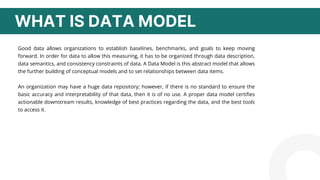
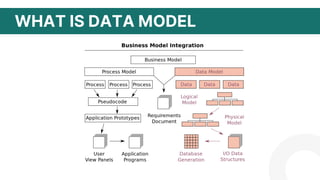
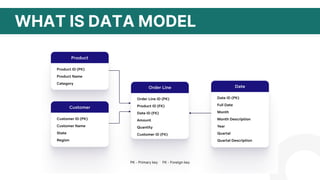
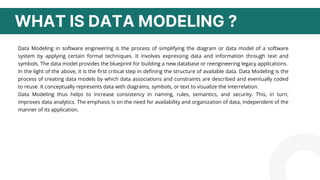
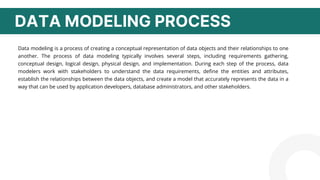
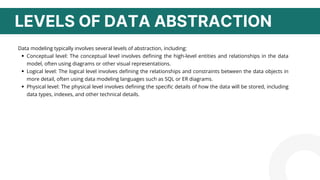

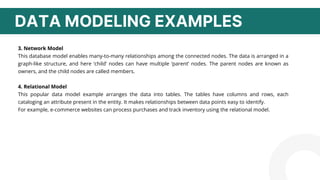
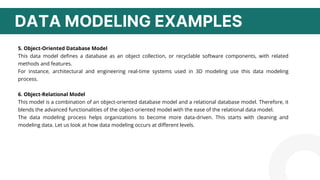



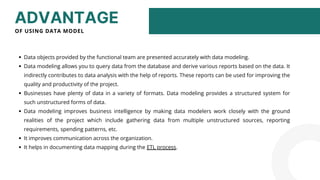
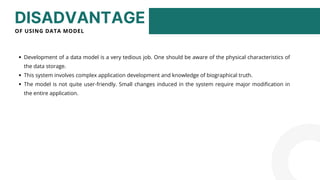
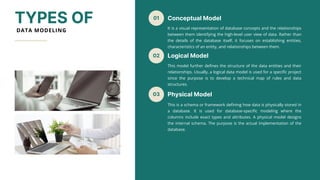

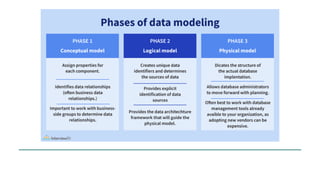


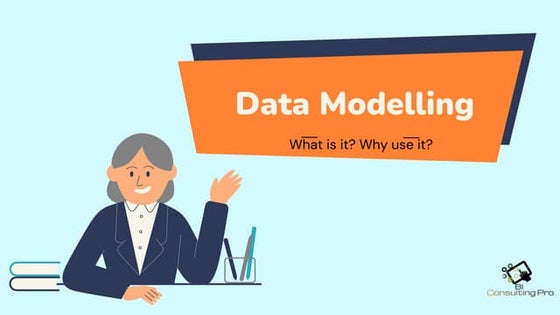


![Data Models [DATABASE SYSTEMS: Design, Implementation, and Management]](https://cdn.slidesharecdn.com/ss_thumbnails/coronelpptch02-datamodels-190903105908-thumbnail.jpg?width=560&fit=bounds)




























![ESET Smart Security Crack + Activation Key 2025 [Latest]](https://cdn.slidesharecdn.com/ss_thumbnails/bagc0125seedtechmaizeppt-250402180805-04ae8272-250402193656-b12a103b-thumbnail.jpg?width=560&fit=bounds)










![[Roundtable] Choreo - The AI-Native Internal Developer Platform as a Service](https://cdn.slidesharecdn.com/ss_thumbnails/choreo-deck-250328074645-511dded7-thumbnail.jpg?width=560&fit=bounds)



